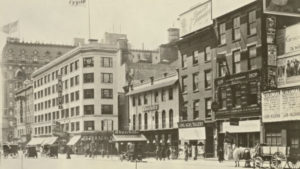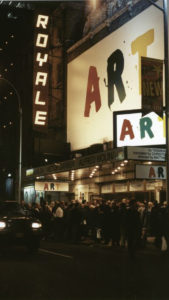For writer/historian/producer Jennifer Ashley Tepper it all started by listening to Broadway musical cast albums while growing up in Boca Raton, Florida. For Broadway, at least as we know it now, it began at the start of the 20th century when the Hudson, Lyceum and New Amsterdam theaters all opened in 1903.

Those seemingly disparate tracks collided when Tepper chose to launch a series of books on the history of the theaters that are still open and those who have found themselves in the dustbin of history. That series, The Untold Stories of Broadway, started when the first book was released in 2013.
Eight years later, Volume 4 has been published. Each book is an oral history (with everyone from stagehands and doormen to creators and performers) on a selection of theaters that are still running and, until this most recent edition, one that no longer existed. Volume 4 has a significant section on what are referred to as The Big Five* theaters that were demolished in 1982 to make way for what is now the Marriot Marquis Hotel and the Marquis Theatre.
Tepper herself is more than just a historian. She has been handling the programming at Feinstein’s/54 Below for a number of years and was one of the producers of the musical Be More Chill.
Recently I spoke by phone with Tepper about Broadway theaters and their history, the naming of theaters and what Broadway might look like on the other side of the pandemic. What follows has been edited for length and clarity.
Before musicals became juggernauts like The Phantom of the Opera and the revival of Chicago, theaters, particularly as described in your book, would experience a far higher rate of turnover than they do now. Do massively long-running shows post as much a problem as they do a financial windfall?
That’s a good question. Broadway is like an eco-system. The long-running shows that have come along, while they do take up theaters, it has allowed Broadway to thrive. People who come to see Hamilton then see five other shows. If you look at the 80s and the early 90s, half the Broadway houses were empty – even with long-running shows. While at the same time, there is a sense that it might be better in some ways if some shows would not run forever and ever.
The Ambassador was a theater that was really long-struggling and hadn’t had a life for years. Chicago changed that. The Gershwin was the same until Wicked. They do have better lives afterwards.
Have you seen a show in each of the theaters you have or will be writing about?
Other than the lost Broadway theaters, yes. I never got to see a show in those. It was fascinating to do interviews about those lost theaters. To do what are called The Big Five that were demolished at all one time. That really changed Broadway history by making it so other theaters were landmarked and couldn’t be torn down.

You make an effort to go as far back as possible when providing the oral history of these theaters. Is there an urgency to get interviews with people like Stephen Sondheim (who turned 91 on Monday) and others who are frankly getting quite old?
That’s been such a thing from the beginning. We’ve had thirteen interviewees pass away since the last book was published. This is a legacy project and I want each history to go back as far as possible. In this book writing about the Morosco and the Gaiety, there’s no one around. It’s always been a level of urgency.
Doug Katsaros (Orchestrator who did dance arrangements for Rockabye Hamlet) drops a little unknown bomb in this book stating that director/choreographerGower Champion died of AIDS in 1980. Was this common knowledge amongst the theater community? I couldn’t find anything publicly announcing that as his cause of death.
My editor and I do a lot of soul-searching about so many things people say in these books. We haven’t seen it anywhere, but that person was there and he said it. In the introduction we say this is these people’s stories and their perspectives. Sometimes three people will talk about the same performance and have three different stories. It’s hard to say. I don’t want to censor someone’s memory since they were there.
Deadline Hollywood has started their own oral history of the postponed revival of Company. One of the comments from Patti LuPone was, “I said goodbye to the Jacobs and then I thought, no, goodbye to the Royal, because the Royale had been a much more elegant theater name than the Jacobs.” What’s your opinion of the renaming of theaters? Do executives deserve the same status as playwrights or composers?

It’s not like we have 41 theaters and they are named for the 41 most esteemed people in theater history. I understand saying The Royale is a more elegant name, but Bernard B. Jacobs and Gerald Schoenfeld changed the industry through the Shubert organization. We don’t have a Hal Prince theater, so it’s not as sensical in the way that maybe some people wish it was.
If you were to write a separate update to this entire series about what the last year during the pandemic has been like for these theaters, what do you think it would have to say?
What was interesting about writing this volume during the pandemic is there are so many times in history that have parallels. Not exactly the same, but other times when there have been strikes or theaters were shut down for a tragedy or natural disaster. That was something interesting to think about. I saw someone working on the marquee at the Imperial. That guy has a story and he’s the only one who’s been in that house for months. I’m sure there will be stories to tell.
What role with theater play when we are all finally able to go back with Playbills in hand and enjoy a show?
There will be shows that will be more uplifting and people will want to be cheered up. Some people will want to go and see something political and reflect the time we are living through. Others will explore other times that are parallel. I’m excited about making theatre. The next step will be to get in a room and work on something.
*The Big Five Theaters were The Astor, The Bijou, The Gaiety, The Helen Hayes and The Morosco
Photo: Jennifer Ashley Tepper (Photo by Stephanie Wessels/Courtesy Dress Circle Publishing)











